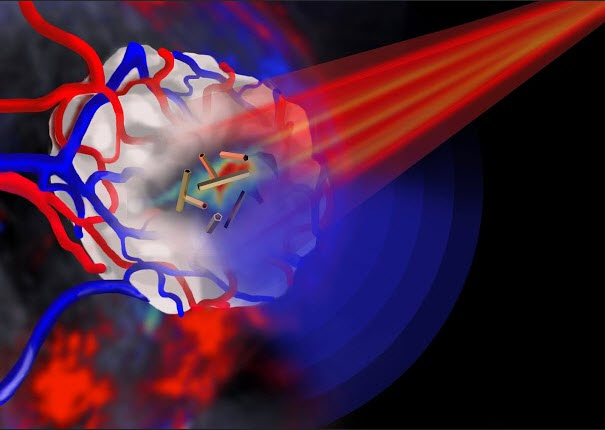
rexresearch.com
Sunjie YE, et al.
Gold Nanotubes vs Cancer
Gold Nanotubes vs Cancer
February 17, 2015
Gold nanotubes image and destroy
cancer cells in three ways

(credit: Jing Claussen/iThera Medical, Germany)
Leeds scientists have shown that gold nanotubes can fight cancer in three ways: as internal nanoprobes for high-resolution photoacoustic imaging, as drug delivery vehicles, and as agents for destroying cancer cells.
The study, published in the journal Advanced Functional Materials, details the first successful demonstration of the biomedical use of gold nanotubes in a mouse model of human cancer — an alternative to existing chemotherapy and radiotherapy methods, which have serious side effects.
“To the best of our knowledge, this is the first [combination] in vitro [lab] and in vivo [live in animals] study of gold nanotubes,” the researchers say.
According to study lead author Sunjie Ye, who is based in the School of Physics and Astronomy and the Leeds Institute for Biomedical and Clinical Sciences at the University of Leeds, “high recurrence rates of tumors after surgical removal remain a formidable challenge in cancer therapy. Gold nanotubes have the potential to enhance the efficacy of these conventional treatments by integrating diagnosis and therapy in one single system.”
Gold nanotube schematic showing hollow interior (left) and transmission electron microscope image (right) (credit: Jeremy Freear/Advanced Functional Materials)
The researchers injected the gold nanotubes intravenously. They controlled the length of the nanotubes for the right dimensions to absorb near-infrared light (which penetrates tissue well) from a pulsed infrared laser beam.
By adjusting the brightness of the laser pulse, the researchers were able to control whether the gold nanotubes were in imaging mode or cancer-destruction mode.
For imaging, after absorbing energy from the laser pulse, the gold nanotubes generated ultrasound for multispectral optoacoustic tomography (MSOT), used to detect the gold nanotubes.
For cancer destruction, there were two options:
Use a stronger laser beam to rapidly raise the temperature in the vicinity of the nanotubes so that the temperature was high enough to destroy cancer cells.
Load the central hollow core of the nanotubes with a therapeutic payload.
The gold nanotubes were coated with protective sodium polystyrenesulfonate (PSS) and were excreted from the body, and therefore are unlikely to cause problems in terms of toxicity, an important consideration when developing nanoparticles for clinical use, the researchers say.
Advanced Functional Materials, 2015
DOI: 10.1002/adfm.201404358
http://onlinelibrary.wiley.com/doi/10.1002/adfm.201404358/abstract;jsessionid=DE57042EFB34E947DDB5CD14BAF5C462.f01t04
12 FEB 2015
Engineering Gold Nanotubes with
Controlled Length and Near-Infrared Absorption for
Theranostic Applications
Sunjie Ye, Gemma Marston, James R. McLaughlan, Daniel O. Sigle, Nicola Ingram, Steven Freear, Jeremy J. Baumberg, Richard J. Bushby, Alexander F. Markham, Kevin Critchley, Patricia Louise Coletta and Stephen D. Evans
Important aspects in engineering gold nanoparticles for theranostic applications include the control of size, optical properties, cytotoxicity, biodistribution, and clearance. In this study, gold nanotubes with controlled length and tunable absorption in the near-infrared (NIR) region have been exploited for applications as photothermal conversion agents and in vivo photoacoustic imaging contrast agents. A length-controlled synthesis has been developed to fabricate gold nanotubes (NTs) with well-defined shape (i.e., inner void and open ends), high crystallinity, and tunable NIR surface plasmon resonance. A coating of poly(sodium 4-styrenesulfonate) (PSS) endows the nanotubes with colloidal stability and low cytotoxicity. The PSS-coated Au NTs have the following characteristics: i) cellular uptake by colorectal cancer cells and macrophage cells, ii) photothermal ablation of cancer cells using single wavelength pulse laser irradiation, iii) excellent in vivo photoacoustic signal generation capability and accumulation at the tumor site, iv) hepatobiliary clearance within 72 h postintravenous injection. These results demonstrate that these PSS-coated Au NTs have the ideal attributes to develop their potential as effective and safe in vivo imaging nanoprobes, photothermal conversion agents, and drug delivery vehicles. To the best of knowledge, this is the first in vitro and in vivo study of gold nanotubes.

CN103990793
High-length-to-diameter-ratio solid-walled hollow gold/gold-silver nanotube and manufacturing method thereof
High-length-to-diameter-ratio solid-walled hollow gold/gold-silver nanotube and manufacturing method thereof
The invention discloses a high-length-to-diameter-ratio solid-walled hollow gold/gold-silver nanotube and a controllable synthesis manufacturing method of the nanotube. According to the method, a high-length-to-diameter-ratio silver nanowire serves as a template; as Au (I) salt is adopted as a gold source in an optimized mode for replacement reaction, the adjustability of the replacement reaction rate and the precise controllability of experiments can be improved; in this way, the wall thickness of the nanotube and the flatness of the surface of the nanotube can be controlled more accurately, and the situation that a porous wall and a uneven surface are produced, or the nanotube collapses or fractures is avoided. The high-length-to-diameter-ratio solid-walled hollow gold/gold-silver nanotube has better conductivity, oxidation resistance, strength, bending resistance, light transmittance and abrasion resistance.
US2005229744
Noble metal nanotube and method for preparation thereof
Noble metal nanotube and method for preparation thereof
Also published as: EP1550632 // JP3842177
A nanotube of which basic skeleton is made of a noble metal element is provided. The skeleton of the nanotube is made of (1) a single noble metal element of gold (Au), silver (Ag), platinum (Pt), palladium (Pd), rhodium (Rh), or iridium (Ir) as noble metal elements, of (2) a mixture in which (Ru) is added to the above (1) in any proportion, or of (3) a mixture in which a base metal element is added to the above (1) or (2) in any proportion, and the noble metal nanotube has a tubular form of about 5-7 nm in outer diameter, about 2-4 nm in inner diameter, about 1-2 nm in thickness, and 10 nm or more in length.